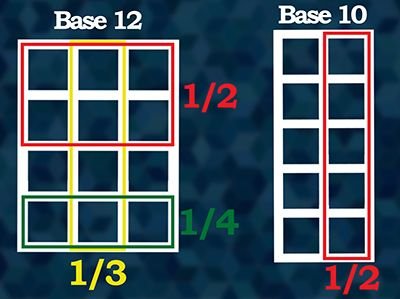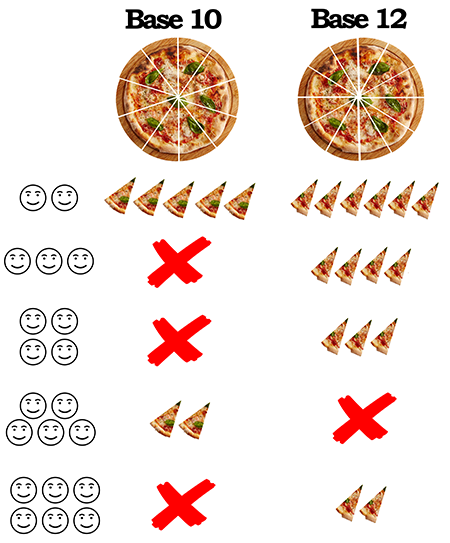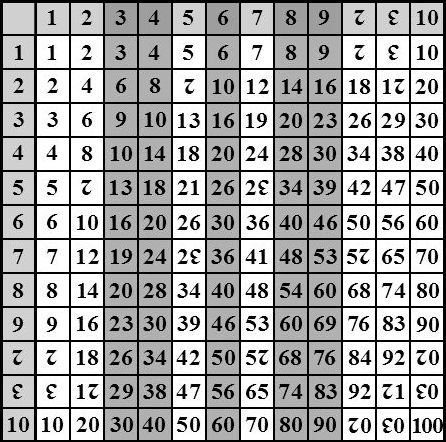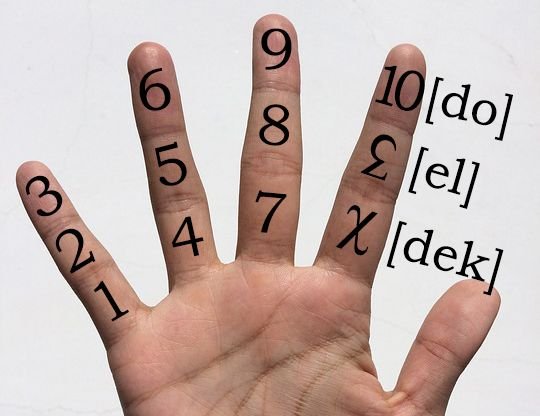Have you ever thought about why we count to 10 instead of 8, 9, 11 or better still 12? The decimal counting system (or base 10) feels intuitive and logical, but is there something better out there?
You bet there is! Base 12 could do a much better job for us in our everyday lives. Let's see why!

Why Do We Use The Decimal Numeral System?
The decimal numeral system is the counting system we are the most familiar with because we use it every day. It uses 10 digits (from 0 to 9) and the position of each digit in a particular number represents a different power of ten. The larger the number, the more digits we use to express it.

For instance we can look at the current year - 2018 - and notice what each digit represents. We have different digits representing the ones (100), tens (101), hundreds (102) and thousands (103). Summing up those powers of ten gives us the number we want to represent. As we all know well from experience, it's easy to represent any number using this system.
But what is so special about ten and why do we count in tens. There are two very simple prongs to this answer.
First of all, we have ten fingers which gives us a clear reference point when counting. This makes us feel more attached to the number 10, so it feels especially round. If we had 4 fingers on each hand, could be counting in chunks of 8 instead of chunks of 10. So the first prong of the answer is sheer evolutionary chance.
The second reason we are using the decimal system is because we are used to it. It's part of our most languages and this is how we are introduced to numbers as children. For pretty much all of us, this system is carved into the way we think about math and numbers and nothing feels more natural. On top of this, everything around us is based on that system and we see it so much that we don't even think about alternatives. This is how entrenched into our lives the decimal system actually is.
But as mentioned above, the fact that random chance and habit are pointing towards a particular solution doesn't mean that this is the optimal solution. And indeed, in a perfect world, we would be able to switch to something superior...

Say Hello to Base 12
Base 12, also known as dozenal or duodecimal, is an alternative numeral system that uses 12 digits instead of 10 and where the position of each digit represents a power of 12 instead of a power of 10. But to start looking at it, we are going to need two more digits to represent ten and eleven. There are different options like using X to represent 10 and E to represent 11 or new symbols like the ones on the right. To avoid confusion, we not only need new digits, but we also need new words for ten, eleven and twelve which are respectively dek, el and do (coming from dozen).
When using this system we can use the twelve digits (from 0 to 9 plus the two new ones) to create numbers in the same way that we used in decimal. The only real difference is that each position would represent a power of 12 instead of a power of 10. This means that we will have 120, 121, 122, 123 and so on. Iinstead of having round numbers that divide by 10, the round numbers in duodecimal will divide by 12.
We can take a look at the numbers from 1 to 24 written in base 12 below with a few corresponding numbers from base 10 written in red for reference.

Just like in base 10, we can continue making larger and larger numbers. When we write 10 in base 12, it stands for 121 or 12. When we write 100 in base 12, it stands for 122 or 144 which is also called gross or gro. When we write 1000 in base 12, it stands for 123 or 1728 which is also called mo and so on. The number expressed as 20 in base 12 (or 24 in base 10) would be pronounced two-do and the number expressed as 200 in base 12 (or 288 in base 10) would be pronounced two-gro.
To get another example of a number written in base 12, we can look at our current year. It might be 2018 in decimal, but it's 1202 in duodecimal:

It might not be very easy to get used to in the begining, but it's actually very similar to the way things work in decimal.
But What Makes Duodecimal Better?
To put in simply, once you get used to it, everyday math would be much easier in duodecimal.
1. Fractions Are Easier
You see, ten has only two factors besides itself and one - 2 and 5. Twelve on the other hand, has more - 2, 3, 4 and 6. This means that counting in twelves gives us the advantage of being able to divide things in more ways more easily. Having more factors makes base 12 much more flexible. The grids below show the important fractions that are easy to do in each system in a way that's hopefully easier to imagine.

A grid of 12 parts is easy to divide into a half, a third and a quarter while a grid of 10 parts is easy to divide only in half. This means that fractions in base 12 are going to be much easier to handle.
To demonstrate this we can use another real-live example. If we have a pre-cut pizza to divide among groups of people of different sizes, cutting the pizza in 12 slices will give us a lot more options to divide it.

We can see that for groups between 2 and 6, a pizza divided in 12 slices gives us a lot more options than a pizza divided in 10 slices.
Well, this works out for other fractions too. Having more factors means that working with fractions is going to be much easier in duodecimal. While ⅓ in base 10 is a problem as it's 0.3333333 with an infinitely recurring series of 3s, ⅓ in duodecimal would be 0.4 as it's 4/12. While ¼ in base 10 is not infinite (0.25), base 12 still offers an improvement with the simple 0.3 as it's 3/12. ½ in base 12 would be 0.6 as it's 6/12.
While there are still some fractions that would have infinitely recurring parts in base 12 like 1/5 and 1/7, using it would still offer a significant advantage over base 10 and most of the fractions we are likely to encounter in our everyday life would be simplified.
2. The Multiplication Table Is Easier
Fractions are not the only part of everyday math that will become much easier in duodecimal. In decimal, the easiest part of the multiplication table is multiplying by 5 as it gives very predictable results with a very simple recurring pattern. This happens because 5 is a factor of 10 which allows for things to line up quite nicely. The results always end in 5 or 0.
Since 12 has more factors than 10, a larger part of the duodecimal multiplication table lines up with recurring patterns that would be much easier to learn and work with. Multiplying by 3, 4, 6, 8 and 9 all result in recurring patterns and only multiplying by 5 and 7 might be a bit more challenging to learn in the beginning.

This would arguably make teaching and learning multiplication much easier. Nowadays, too many children are afraid of math and if we can make the type of math they are going to encounter early on easier, we would be less likely to scare them away from it. But having an easier multiplication table makes life easier for everybody.
An additional bonus that the duodecimal multiplication table offers is the fact that it actually covers a bit more ground before you have to switch to non-integer multiples. The decimal multiplication table reaches 100 while the duodecimal reaches 144 which means that an average person would be able to quickly calculate results for a slightly broader set of numbers after learning it.
But We Have 10 Fingers! Wouldn't Teaching Base 12 Be Too Confusing Without Using Your Fingers?
When we learn to count as children, we do indeed use our fingers, but this doesn't mean that we can't still use them in base 12. Instead of counting on our fingers, we can count on the segments of our fingers on one of our hands and viola - we get a clear visual representation of a dozen:

This also has an added bonus of clear visualizations of halfs, thirds and quarters just by looking at our hands.
It turns out that if we had been taught to count in twelves instead of in tens, both using and learning simple math would be significantly easier.
So Why Don't We Switch To Base 12 Right Away?
Unfortunately, life is never that simple. If we started learning base 12 as children, it would be easier, but switching to a new numeral system as an adult is going to be a huge pain for all of us. As mentioned in the beginning, one of the main reasons we are using decimal is that this is what we know and what we are used to. If we switched to base 12, base 10 would always feel more natural for those of use who grew up with it. And this is going to be essentially all of us.
On top of this, it's not only our heads that would need changing, it would be everything around us. Numbers are everywhere - from speed limit signs, through calculators and computer keyboards, to money. If we want to change the counting system we are using, we are going to have to change everything. We would need new calculators, we would need new computer keyboards, we would need software updates, we would need to change the dashboards on all kinds of vehicles and equipment and we would need to change virtually all signs. It's not only going to be a huge mess, but it would also cost a ton of money.
That's why, I don't think we are ever going to see duodecimal becoming the accepted way to count anytime in the foreseeable future. There would be some benefits, but the costs are simply prohibitively high. Additionally, all the benefits of base 12 can be felt in everyday math, but it doesn't really change much about the more complex math used in science or engineering. In the end, despite the fact that it's not perfect and that we have a better option, base 10 is simply good enough for us to keep using it even if we know we have a better option.
If only our fish ancestors had preserved an additional bone in their flippers for us to have 6 fingers on each hand...

Sources:
- http://www.dozenal.org/drupal/sites_bck/default/files/db38206_0.pdf
- http://www.dozenal.org/drupal/sites_bck/default/files/db4b224_0.pdf
- https://en.wikipedia.org/wiki/Duodecimal
- http://www.dozenalsociety.org.uk
The images and illustrations in this post are all original work based on the following CC0 sources and graphics released into the public domain like the different dek and el symbols:
- https://pixabay.com/en/cube-background-background-pattern-2484131/
- https://pixabay.com/en/color-abstract-background-textures-3134831/
- https://pixabay.com/en/palm-hand-finger-bleaching-1701989/
- https://pixabay.com/en/pizza-food-italy-3000285/

Being A SteemStem Member
Hey Dave. This is really good.
Haven't heard from you in a while, mate.
Everything okay?
I second this. Hope all is well @rocking-dave
I recently researched this topic when working on a post for a series on temperature measurements. Basically Celsius referenced 0 for freezing, and 100 for the boiling point of water. While Fahrenheit used different points of the coldest solution in his lab for 0, and his body temperature for 96. At first I wondered why 96, and it turns out he choose 96 because it was divisible by 12 for the reasons mentioned above.
Great post! --3D
That's actually quite interesting, I didn't know that! To make this coincidence a bit more significant, I actually have an unfinished post about temperature in the can that I haven't published yet :)
For accuracy, I should mention In 1742, Swedish astronomer Anders Celsius referenced the freezing point of water as a 100 degree point, and the boiling point of water as the 0 degree point. In 1744, coincident with Celsius death, the Swedish botanist Carl Linnaeus (1707–1778) reversed Celsius's scale such that 0 was the reference for freezing and 100 for boiling.
The research on Fahrenheit and base 12 matched the point in your article, but I realized I had Celsius backwards, or maybe he did :-)
Enjoyed your post, and as mentioned it was in phase with my research. I look forward to more! Maybe you can get the post on temperature published. It will be interesting to see what areas you focus on.
Yep, Celsius started with an inverted scale where the colder it was the higher the number for the temperature was and I think somebody else started reversing it in the direction we are used to today.
I was actually wondering about this a couple months back! Didn't bother to google it and here you are answering the question! Quite interesting. The part about the finger-segments had me saying 'damn, these duodecimal people have an answer for everything' haha!
Good post, and informed replies in the comment section.
I'm glad you liked it! :) I agree, the finger segments thing is quite ingenious. But if another base was more useful mathematically, I'm sure we would have found a creative way to visualize it.
This has got to be the most interesting thing i have read in a while now. Those figures dont look or come intuitive at all, but given the advantages over base 10, its worth learning and and applying to everyday problems. I'll give it a try
I'm glad you found it interesting. The true benefits of base 12 would come only if everybody was using it, otherwise you'd still have to do conversions between base 10 and 12 all the time which will eliminate all the utility. Still, it's a fun and mind-expanding exercise to try and "think" in another numeral system. :)
Yes it is. well, it would be fun learning this. It's been a while buddy.
I don't know if I'll ever be able to use my mind for math. I'm afraid not. It kind of doesn't want to. I think all the connections and spaces up there are already taken. LOL. I have spent some time with the Chinese multiplication method for children, did I tell you? Because that's pretty much the only thing I can say.
Maybe that is something for another post of yours? Like a piece of education for parents who would like to teach elementary kids in mathematics and are bad at it, themselves. I actually was back then desperately looking for this on the Internet.
But what I really want to say - excuse my chatting, is that your article is of artistic beauty, produced with a lot of love and effort and THAT is something I can still recognize!
Oh, the Chinese multiplication method is so cool! So pleasantly visual and analytical.
Thank you for the kind words! I try to do my best to present the concepts as clearly as possible and I hope they are at least some bit understandable to somebody who doesn't really have a "math brain".
you're welcome.
I was able to follow the dividing part but then you lost me:)
did you, btw, make the graphs yourself?
Imagine, what a piano player could do with six fingers on each hand. LOL
Well, the part about division is the important part really ;)
Yep, I made the images, but I used existing CC0 and public domain graphics for some of them like the shot of the pizza (that I sliced awkwardly :P), the hand and the backgrounds.
Oh, I love this article!
I have an old English friend who use to say that they have the "proper system" because they count in dozens instead of decimals... haha
But apart from this, I am working with groups most of the time and my favorite group setting is having 12 people in a team, for the very same reasons that you described with your pizza example... It is just easier to form small groups or pairs, it works many ways perfectly.
Great article, very educational! :-)
Congrats!
I'm really glad to hear that! :) Your friend indeed has the proper system :)
Dozens are indeed easier to work with and more flexible.
I adore base 12, but the sheer cost logistically of switching society over to it would be absurdly prohibitive.
Unfortunately that is indeed the case. We not only need to change all our tools and devices, everybody needs to change the way they think about numbers. I love the idea of base 12 too, but I'm sure I'd struggle big time if switched. Most people would simply not want the hassle. It's a pity we didn't move into dozenal earlier before decimal got so deeply entrenched into our minds and lives.
Preach it.
Hehe, I still like base 10 more because of how easier it looks. Maybe if we were all conditioned into base12 instead of base10, that would be easier for us and base10 would be weird.... but I find the ease of calculating 10%, 1%, 0.1% and other number manipulations just look easier on base10.
The only reason base 10 looks logical and familiar is that we grew up with it, so it's now an entrenched in the way we see numbers. Around the world there are and have been all kinds of cultures with all kinds of counting systems like base 5, 20 and 12. Everybody is comfortable with the system they grew up with.
We could have a variation of what percentages are in base 10 in base 12 too, but they will be per 144 instead of per 100. And there would still be round figures - 10% would be 1/12 instead of 1/12, 1% would be 1/144, 30% would be 1/4, 40% would be 1/3 and 60% would be 1/2. If you want a basic intuition for percentages in base 12, imagine a clock face and add zeros and the percentages correspond to the distance around the clock covered from twelve - 3 is at 1/4, 4 is at 1/3 and 6 is at 1/2.
The base 10 percentages are both equally arbitrary and equally logical, we have just gotten used to them.
And yes, for adults, it might actually be impossible to develop a base 12 intuition that is as good as our already developed intuition for base 10 is and base 10 would probably always feel more natural for most of us. That's yet another reason we'll most probably never see base 12 implemented in any way.
Great Article.
I think there is an easier way for counting with the fingers:
Use the hand without any Fingers as a number.
No hands shown = 0
One hand without any fingers = 1
One hand, one Finger = 2
...
One hand, 5 fingers = 6
One hand, 5 fingers and second hand without fingers = 7
...
This would be easier for kids because you can show somebody these numbers with your hand, what is not possible with the other method.
Interesting method, I like it! :)
The method with the finger segments allows for visual representation too since you can use your free thumb to point at a particular segment while having the non-counted fingers closed for clarity. As a bonus you can represent all 13 numbers from zero to 12 on one hand.
Congratulations! This post has been upvoted from the communal account, @minnowsupport, by rocking-dave from the Minnow Support Project. It's a witness project run by aggroed, ausbitbank, teamsteem, theprophet0, someguy123, neoxian, followbtcnews, and netuoso. The goal is to help Steemit grow by supporting Minnows. Please find us at the Peace, Abundance, and Liberty Network (PALnet) Discord Channel. It's a completely public and open space to all members of the Steemit community who voluntarily choose to be there.
If you would like to delegate to the Minnow Support Project you can do so by clicking on the following links: 50SP, 100SP, 250SP, 500SP, 1000SP, 5000SP.
Be sure to leave at least 50SP undelegated on your account.
Nice post. Just as an addendum. Here is the numerphile video about this topic
That's a great video. James Grime is always a pleasure to watch :)
I mean, you could count from 1-16 on one hand by using your thumb to point to your fingertips and knuckles. So why not just use hexadecimal, instead?
Counting to 12 on your fingers is not an advantage of base 12, it just shows that it's not in disadvantage compared to base 10. Base 12 is considered superior to base 16 because it has more prime factors. In base 12 half, third and quarter are quite simple, while in hexadecimal 1/3 is still going to have an infinitely recurring part. That's why duodecimal could be better for everyday calculations. That's the selling point that makes it better than both decimal and hexadecimal, not giving you the ability to count on your fingers.
There are all kinds of cultures that count not only on their fingers, but on their entire bodies and they can reach all kinds of really big numbers in all kinds of ways.
Nice post @rocking-dave I am Upvote and followed you,, thank for information....

Highly reasonable points . but you made no mention of its relation base 2; the digital base which alone our computers understand
Base 12 and base 10 are related to base 2 in a very similar way and both require the same type of conversion from and to base 2. From the point of view of computers, there is no real difference between base 12 and base 10. Base 12 might be easier for human use, not computer use.
What would fit computers better might be the bases that are powers of 2 like base 8 and base 16, but they hold no real advantage over base 10 for us.
Yes base 2 is related to base 8 as base ten to 100s. But base 8 cant give so much advantages as you outlined about 12 in day-to-day arithmetics.
The other problem I see about changing to any other base is that even if our children learns it, they will need to be in an isolated world to use it. If some body mastered to base 12 writes the figure 10, it means twelve to him in base ten but to me it means ten. This would rather be a confussion between the older and younger generations.
Anyway, your post is superb and I see every point you made to be true.
Yep, switching now would be a huge pain and would create more problems that it would solve. :) Despite the fact that base 12 is objectively better, the difference and the benefits would simply not be large enough to warrant a transition.
@rocking-dave, where you been at man? Been a while since you've been active, hope all is well!
Congratulations @rocking-dave! You received a personal award!
You can view your badges on your Steem Board and compare to others on the Steem Ranking
Do not miss the last post from @steemitboard:
Vote for @Steemitboard as a witness to get one more award and increased upvotes!